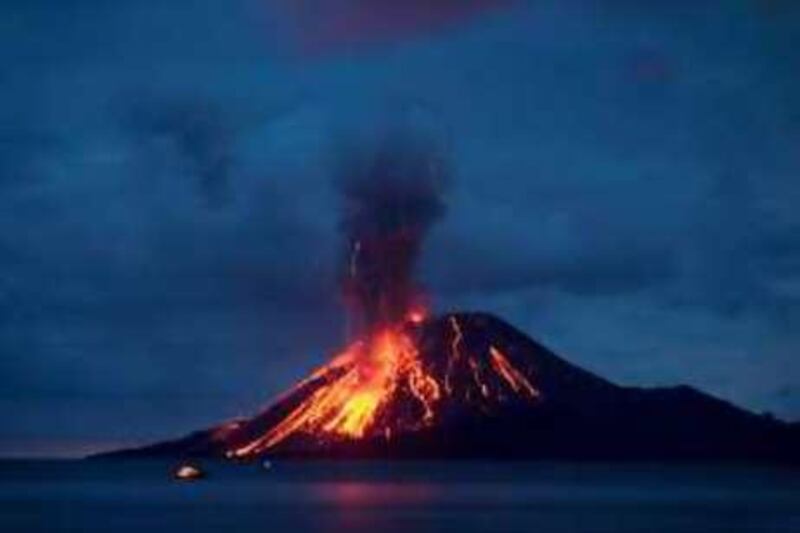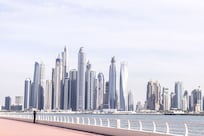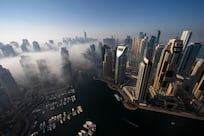The residents of Naples could be forgiven for sleeping uneasily. The city in southern Italy sits in the shadow of the volcanic Mount Vesuvius, whose eruption buried the Roman city of Pompeii in the year 79AD. Vesuvius last erupted in 1944, but a study by a team of Italian and French scientists published in the journal Nature suggests there could be more activity to come. The researchers "cannot rule out" an explosive eruption of the volcano, whose conical shape is the result of the accumulation of lava flows and ash.
With 700,000 people living in the vicinity of Vesuvius, it is no surprise the city's authorities have plans to evacuate the area and move residents to other parts of the country if the volcano begins to rumble. Evacuation would take about a week, which is well within the safety window as officials expect that the volcano would start showing signs of activity at least two weeks before an eruption. In fact, according to Dr Clive Oppenheimer, reader in volcanology and remote sensing at the University of Cambridge's department of geography, volcanoes usually give warnings months or even years before an eruption occurs.
He admits, however, it is no easy task to distinguish between the rumbling volcanoes that are about to explode, and those that are just teasing. Often, he says, the volcanoes that have been active before, but have been dormant for a while, are the most dangerous. Molten rock, known as magma, may have been slowly building up pressure for a long time. "Some of the largest explosions have been in volcanoes we knew nothing about. They tend to happen in volcanoes that haven't done anything for a long time so we don't have a good record," he says.
While the residents of Naples still have cause for concern, people living in the Scottish capital, Edinburgh, have little to fear. They can look skyward and see a 251-metre volcanic hill called Arthur's Seat, but the chances of it coming to life appear non-existent. It last erupted more than 300 million years ago. "There are definitely extinct volcanoes that are very ancient," Dr Oppenheimer says.
More problematic are those in the "fuzzy boundary" when the last eruption was between tens of thousands and hundreds of thousands of years ago. It is still possible, Dr Oppenheimer says, for this types of volcano to erupt. Even if a volcano does become active again, it is not always a cause for alarm. Much depends on whether the eruption is explosive and sends vast amounts of ash and other material into the air, or effusive, with the lava released as a steadier flow.
The type of eruption depends upon the acidity of the magma, with more acidic material tending to be more dangerous. Acidity, says Professor Stephen Sparks, director of the University of Bristol's centre for environmental and physical flows, varies according to the magma's silica content. "The more explosive tend to have a lot more silica. They are more viscous. The low silica [magma] runs down the volcano fast," he says.
While a single volcano can erupt in different ways, some have a tendency to be more explosive than others. Livelier eruptions are more common in volcanoes formed near the boundaries of tectonic plates, where one plate is being pulled beneath another, a process known as subduction. Most volcanoes form at subduction zones and mid-oceanic ridges, with the remainder linked to localised hot spots. When subduction happens, rocks with a high water content are pushed down, causing them to melt.
"The magmas tend to be much more silica rich and have water, which makes them much more explosive," explains Prof Sparks. The gaseous water creates huge pressures as the magma rises to the surface, causing an explosion. More explosive volcanoes blow the tops off, leaving rimmed crater known as a caldera. Those that erupt effusively, releasing a very fluid basaltic magma, form gently sloping basalt plateaus that can cover vast areas.
In between are composite volcanoes such as Vesuvius, that depending upon their mood, erupt explosively or effusively. Such volcanoes are made of alternating layers of ash and flowing lava. Just as the effect a volcano has on its surroundings depends upon how it erupts, so its global impact varies according to its location on the planet. With massive explosions, global climate is affected more when the volcano is closer to the equator, since there is more sunlight for the ash blasted into the atmosphere to obscure. Also, ash can be drawn into both hemispheres.
By contrast, material erupted at higher latitudes tends to be drawn towards the poles, with more localised effects. "Vesuvius is not in the tropics. A big eruption could have an impact on [the climate of] the northern hemisphere, but it would have to be really big," explains Dr Oppenheimer. When Tambora in Indonesia erupted in 1815 between 30 and 50 cubic kilometres of ash were released. Such a large tropical eruption had a cooling effect far into the northern hemisphere, with temperatures diving 3°C to 4°C below average.
"This is almost certainly linked to a shorter growing season in parts of North America and Europe in 1816," says Dr Oppenheimer. "It came to be known as the year without a summer. There were lower crop yields and social upheavals linked to this." The 1991 eruption of Mount Pinatubo in the Philippines caused a 0.5°C reduction in global temperatures. When Mother Nature decides to really show us what she is made of, the effects are on a grander scale altogether; vast numbers of species can be driven to extinction.
There are eruptions that Dr Oppenheimer says "clearly coincide" with mass extinctions. "The biggest extinction in the fossil record, at the end of the Permian about 250 million years ago, coincides with an eruption," he says. "And there are several others in the fossil record. These involve millions of cubic kilometres of lava. The climatic impact stems from the gases and the particles released. It can have a great effect on biological productivity and ecosystems."
Some believe the most famous mass extinction, the disappearance of the dinosaurs 65 million years ago, was hastened by a volcanic eruption. "The argument is that a very explosive eruption in India at the end of the Cretaceous, around the time of the end of the dinosaurs, produced huge amounts of sulphur that would have had a major climatic impact," Dr Oppenheimer says. While this suggestion has some support, a more likely scenario, he says, is that an object crashing into earth was responsible.
But even if they did not wipe out the dinosaurs, volcanoes have still chalked up plenty of victims over the years. dbardsley@thenational.ae







